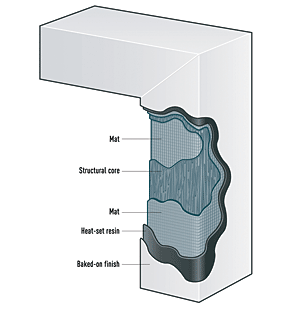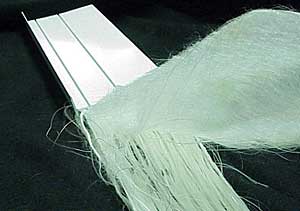Fiberglass Fenestration: A Durable, Sustainable, and Economic Alternative for Windows and Doors
Fiberglass Pultrusion
Fiberglass is made by a process called pultrusion, in which thousands of glass fibers are pulled through a die. In contrast, aluminum and vinyl are extruded, which means pushing a material through a die to shape it.
Fiberglass composite consists of glass fibers and the resin that bind it together. Glass fiber has a high tensile strength, and will not break, similar to a reinforcing bar in a concrete mix. The resin acts like concrete, because it performs well in compression. Together, the glass fibers and resin are good in both compression and tension, creating a strong material.
|
Continuous strands of glass fiber roving and glass fiber mats are impregnated with thermo-set polyester resin, then drawn through a steel die, which sets the shape. Part of the die is heated to initiate the resin's cure process. The end product is a thermoset fiberglass composite. The hardened portion is then pulled from the die and cut to length. Very high strengths can be achieved with fiberglass, due to high glass concentration and orientation of glass rovings and mats parallel and perpendicular to the length of the material drawn through the die.
Once the material has been pulled through the die and cured, a UV resistant coating must be applied. The thermoset polyester resin used in fenestration fiberglass composites will degrade if exposed to the sun for extended periods. The specific coating used varies by manufacturer, but the three most common coatings used are paint, whether water or solvent based, acrylic cap-stock, and powder coating. All three provide the UV protection required, but there can be performance differences in terms of long term chalking and fading as well as scratch resistance.
Thermoset versus Thermoplastic
When evaluating alternatives to wood and aluminum, a key factor to consider is the type of resin used to make the alternative material. In general, all resins can be put in one of two categories: thermoplastic or thermoset. In simple terms, thermoplastic materials can be re-melted and thermosets cannot. Most commonly used plastics are made from thermoplastic resin. These materials soften as they heat up and if heated high enough, will melt. This is how plastics are recycled. Thermoset materials, in contrast, undergo an irreversible chemical reaction. Often initiated by heat, once this chemical reaction has occurred, thermosets do not soften or melt as they are reheated.
|
Fiberglass composite windows and doors are made using thermoset resin. Vinyl windows, however, are made from PVC, which is a thermoplastic resin. As a result, fiberglass composite windows can be used in hot climates and can be painted dark colors, even in high sun exposure applications. If vinyl windows are used in these applications, it is possible for the vinyl to soften, causing the material to sag or warp. The term, "vinyl smile" is sometimes used in the industry to describe this phenomenon. This is most often seen when the head of a large span sags after becoming too hot.











